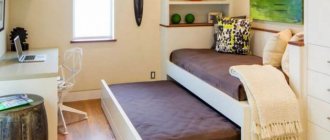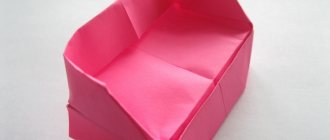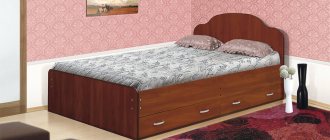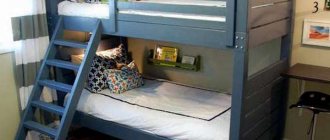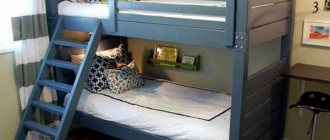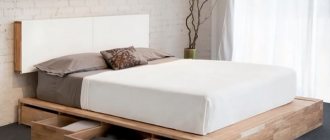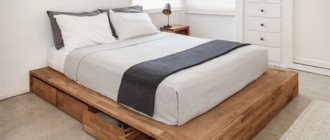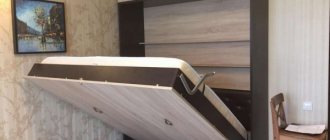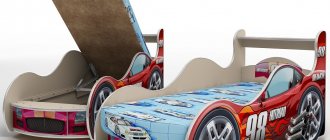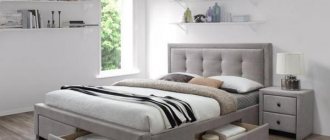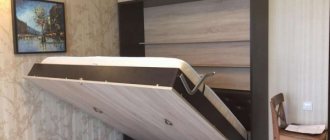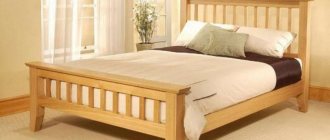Standard beds offered by furniture stores cannot always satisfy individual needs. Our article will serve as a guide for you, how to make a bed from chipboard with your own hands. It is no coincidence that many craftsmen choose this particular material for their home projects: chipboard is easy to process, the products are not too expensive, environmentally friendly, and have an attractive modern look. You will learn, how to make a double bed with drawers from chipboard, you can download drawings of a single bed or make a bed on the podium. Here you will find complex and original models, and a novice master will easily make simple bed made of laminated chipboard or build a crib with your own hands. You will also learn about the main differences between laminated chipboard and conventional chipboard and the advantages of this material. We are pleased to offer interesting and original ideas for using laminated chipboard for making beds at home.
Where can I put it?
Incorrect placement of a sleeping place can lead not only to poor sleep, but also to worsen your well-being, cause bad mood and migraines. It is worth listening to some tips to ensure the correct installation of the product.
In order for the bed to meet your requirements, and its price to be minimal, you need to limit yourself only to your own efforts.
When the door is located opposite the window, a draft begins to circulate in the room. This option is categorically unacceptable. Do not place the bed with its back to the window, opposite a mirror or in a corner. The best option is diagonally to the door. It should be close to the wall, with the head facing east or north.
Despite the rules of Feng Shui, it is best to place the device in a niche, if of course there is one. Thanks to this, a person will receive a feeling of protection, security, comfort and coziness. Being near a window will bring some inconvenience: bright sun rays, noise from the street, etc. Negativity can be softened with thick curtains.
The material for furniture should be easy to process and have an affordable price.
Poor places include walking through or near a door. In this case, you won’t be able to relax, because the bustle of everyday life will constantly interfere. The optimal temperature is not maintained near the radiator, and near the window there is a risk of catching a cold due to drafts. If the wall borders the kitchen or bathroom, this option will also not lead to a comfortable stay.
From all of the above we can summarize the following:
- the best installation is with the headboard against the wall;
- corner of the room - ideal location for a single bed;
- diagonally from the front door - a pretty good option.
Do not forget about the design of the bed, because it should fit harmoniously into the room and match other furniture.
If there is a double bed, then there must be a free passage to each of its sides. It is advisable that the sleeping place be darkened, quiet and calm.
Dimensions
A laminated chipboard bed may differ in various parameters. One of them is classification by size:
- single;
- one and a half;
- double
The dimensions of the berths vary slightly depending on the manufacturer. Standard Russian-made beds are usually made with lengths of 190, 195, 200 cm. Non-standard models have lengths of 210, 220, 230 cm.
The width depends on how many seats the model is designed for.
Single beds have a width of 80, 90, 100, 120 cm, single beds are made with a width of 140-150 cm. The width of spacious double beds is 160, 180, 200 cm. In addition, cribs for very small children and sleeping places of various sizes for children are produced adolescence.
You can purchase a bed made of laminated chipboard of any configuration, color and size to order. In this case, the dimensions of the bed are dictated by the customer. The laminated chipboard bed can be seen in the photos of manufacturers producing modern, reliable furniture that will last for many years and will decorate any interior design.
Making a bed from laminated boards
At home, you can assemble several types of beds: from simple single beds to complex structures equipped with various mechanisms.
- Single bed.
Single bed
These products are very simple in design and consist of a minimum of elements.
The following options not only allow you to triple the sleeping space, but also help optimize the use of living space, which is especially important in small apartments.
- Double bed with drawers.
Double bed with drawers
This design is functional, as it becomes possible to put linen and pillows in drawers installed under the bed.
- Design with a lifting bed.
Bed with a lifting mechanism
The advantage of installing a lifting mechanism is the organization of places under the bed for storing bedding and other things, for example, household supplies.
- Bunk bed.
Bunk bed
Placing two beds on top of each other helps to significantly save usable space.
Types of bunk beds
- Wardrobe bed.
Bed-wardrobe
When folded, this design does not take up much space, but if you take it apart, you get a comfortable and spacious sleeping place for two. Inside the cabinet it is possible to install narrow shelves for placing small items - cream, glasses, etc.
- Podium bed.
Podium bed
Recently popular designs attract attention with the possibility of creating an interesting architectural object in the room that attracts attention. The second advantage of such a structure is the use of space under the podium for storing things. If the bed level is located high above the floor surface, you can build full-fledged chests of drawers with a system of roll-out drawers.
Some tips for making a bed.
- The flooring, which is the base for the mattress, can be made of a single sheet of chipboard or plywood, or also made of slats. The second option is more correct, since in this case the mattress is well ventilated. If the first method is chosen, it is recommended to make holes in the slab for air access.
Slat flooring - Do not tighten all the fasteners tightly at once. It is recommended to do this after assembling the entire frame.
- To make the bed look attractive, it is possible to purchase plugs for fasteners and a facing edge, for example, melamine. It can be easily glued to the ends of cut slabs at home using an iron. Edges are purchased at construction stores. The color can be selected depending on the chipboard coating. In addition to performing decorative functions, edgings serve to protect the ends from mechanical damage and moisture. They also prevent the release of formaldehyde from chipboard. When using an edge to process the edges of slabs, it is necessary to take into account its thickness in the calculations. If the melamine variety does not have a significant effect on the dimensions (its thickness does not exceed 0.4 cm), then ABS or polyvinyl chloride edges are available in thicknesses from 0.4 to 3 mm. When they are fixed at two ends, there is a significant increase in the size of the slab.
- Often the size of the bed is determined by the size of the existing mattress. It is recommended to provide a small distance between the mattress and the frame so that the bed can be made. For this, one and a half centimeters on each side is enough.
- The attractiveness of the bed largely determines the appearance of the headboard. Even a fairly simple structure made from chipboard can be decorated: give the headboard an interesting shape, decorate it with carvings, paintings or decorative inserts, cover it with eco-leather or fabric, after inserting foam rubber.
The headboard should be attractive
Bed production diagram
The assembly of any structure is carried out according to one algorithm.
- To produce a product, you first need to draw up a drawing where all the dimensions are indicated. You can do this yourself or find a ready-made solution.
Drawing of a bed with drawers
Single bed drawing
Bunk bed drawing - A specification of parts is drawn up.
Parts Specification - The material is purchased, and the chipboard is sent to a specialized organization for cutting. This work is inexpensive, but the quality of the edges does not compare with what can be obtained by processing the slabs with your own hands. If you are confident in your abilities, you can cut yourself.
- Tools are prepared: screwdriver, level, square, hammer, tape measure, confirmation key, materials: hardware, corner fasteners, and other fittings if necessary. Usually all the necessary tools are available on the farm, so there is usually no need to purchase anything additional.
- Decorative edges are glued to the ends of the sheets that remain uncoated after cutting.
- The bed frame is being assembled. To do this, the headboard, footboard and side walls are fixed to each other. Self-tapping screws, European screws and metal corners are used for connections. The result is a rectangular box.
- The support beams (transverse and longitudinal) are fixed.
- Slats or bars are fixed to the side walls, which serve as the basis for the flooring.
- The slats are attached to the slats with self-tapping screws, forming a base for the mattress, or a sheet of plywood (or chipboard).
- Garbage is removed.
- You can place a mattress and bedding on the finished bed.
Bed assembly example
Beginning craftsmen can gain experience by producing a simple single-bed structure with a sleeping area measuring 2000 x 800 mm.
You can make a simple single bed
To make the structure you will need blanks made of white chipboards, fasteners and metal corners. It is recommended to use confirmats as hardware for connecting the frame.
Components of the product: headboard, front wall, two side slats, two bars for fastening transverse parts (there are 11 of them).
- The bars on which the grating will be laid are fixed to the sidewalls.
Fixing the bars to the sidewalls - The bed frame is being assembled. To do this, markings are made for holes for fasteners, they are drilled, the sides are connected to the headboard and footboard.
Assembling the bed frame - For additional strength, it is recommended to secure the structure with metal corners.
- Transverse planks are laid on the bars in increments of no more than 10 cm and secured.
Laying cross strips
The main thing when making a bed is to correctly cut the workpieces and secure them, checking the geometry using a level. To add aesthetics to the design, you can shape the headboard. The main advantages of such a structure are the minimum number of components, quick assembly and low cost of the entire structure.
As you can see, making a bed with your own hands is quite possible. By putting in your own work and using cheap material, you can get a very budget-friendly design, but the appearance and quality of which will delight you for many years.
Types of foundations by type of design
There is another classification of bed bases, focused on their functionality.
- Collapsible. This is one of the types of orthopedic base. It consists of several elements: a frame, lamellas (slats), lath holders and legs. This design is easy to assemble according to the instructions and convenient to transport. Improves the orthopedic properties of the mattress.
- All-welded bases. They are a solid or lattice structure made of wood or metal. Immediately ready to use. The most reliable option for heavy mattresses and heavy people.
- Lifting. These models are equipped with a mechanism that lifts the base and provides access to the drawers under the mattress. Allows you to save space in small bedrooms.
- Frameless (liners). They are a tape of lamellas fastened together. The mobile design does not have legs or lathe holders. The frameless base is inserted into the bed frames.
- Transformable. This is a premium orthopedic lifting bed base. Thanks to a special mechanism, the transformable base can be adjusted to the position of the body. If you are used to reading or watching TV in bed, then you can raise the headboard. Also, the lower part rises for a comfortable position of the legs.
- With adjustable hardness. Using special attachments on the lamellas, you can change the rigidity of the base, taking into account specific requirements and health conditions. For example, add rigidity in the lumbar region.
Let's sum it up
Now you know how and what to make a double bed from. If you have any questions about the assembly, ask them in the comments to the article.
Did you like the article? Subscribe to our Yandex.Zen channel
August 3, 2022
Timber, Furniture, Finishing timber
If you want to express gratitude, add a clarification or objection, or ask the author something, add a comment or say thank you!
What is laminated chipboard and what is the difference from MDF?
MDF , medium-density fiberboard, is produced by pressing small wood fibers. Natural lignin and synthetic compounds (in small quantities) are used as binding components.
MDF
Chipboard is produced by hot pressing of wood processing waste with the introduction of thermosetting adhesive resins. The result is a material that is sufficiently resistant to temperature changes, has a homogeneous structure, is easy to process and durable, which is actively used in furniture production. Requirements for slabs are regulated by GOST 10632*2014. The big advantage of chipboard over MDF is its low cost.
Chipboard
However, there are also disadvantages that need to be warned about.
- the material is not intended for fine processing;
- the slightly loose structure does not allow re-installation of the fasteners (when the screw is turned out, the material begins to crumble and for the next installation of the hardware it is necessary to either make a hole of a larger diameter or drill at another point);
- The biggest problem is the use of phenol-formaldehyde resins in production, which leads to the release of harmful substances (if the permissible concentration is exceeded) for health.
In accordance with GOST, the scope of application of chipboards with various indicators of formaldehyde emission is limited.
Scope of application of chipboards with various indicators of formaldehyde emission
By the way, in many countries the production of chipboards with emission class E2 is prohibited. You can find out the exact characteristics of the material only by reading the quality certificates, which not everyone does. A clear sign of the presence of harmful impurities in the material is a strong odor.
In connection with the above, despite the fact that the standard allows the use of certain types of slabs for the manufacture of children's furniture, this is not recommended. Children's health is more valuable.
Laminated chipboards are obtained after applying a decorative coating to chipboards (lamination or lamination). As a result, furniture makers have at their disposal an inexpensive but excellent-looking material, which has also received additional strength qualities and resistance to external influences.
laminated chipboard
Important! Laminated chipboard may have additional properties: increased moisture resistance or fire resistance, which is achieved by using special impregnations.
Types of laminated chipboard
The classification of laminated particle boards is carried out in different ways. However, the following division by type is most often used.
Table. The most commonly used types of chipboard.
| Marking | Distinctive characteristics |
| B.S. | The material is mainly used for the production of office furniture |
| S.E. | The surface resembles the texture of wood with pores |
| S.M. | Smooth surface slabs |
| MAT | Boards laminated with matte film |
| PR | Material with a porous structure |
| P.E. | The laminated surface has an orange peel texture |
In furniture production, BS or PR boards are mainly used (for the production of tables, beds or cabinets) or SM, ideal for the production of partitions.
There are several types of laminated chipboard.
In addition, the choice of material is made depending on the thickness and color required for the manufacture of structures. Sheets are produced in thicknesses from 0.8 to 3.8 cm, the most common values being 1, 1.6, 1.8, 2.2, 2.5 and 2.8 cm. For furniture production, boards with a thickness of from 1.6 to 2.2 cm. The larger this figure, the more significant loads the chipboard can withstand. Accordingly, the price of products increases.
